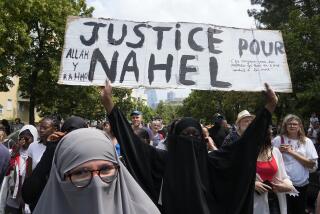A rich history of mixing
- Share via
WRITING FROM NEW ORLEANS — Four years after New Orleans Mayor Ray Nagin tried to endear himself to black voters by playing to their fears that they were about to be “overrun by Mexican workers,” things have and haven’t changed.
Mexican and other Latin American migrants who came to rebuild in the wake of Hurricane Katrina didn’t overwhelm the city. But, at roughly 15% of the population -- up from 3% pre-Katrina -- they aren’t going away either, and New Orleans is grappling with their presence as part of a larger post-disaster demographic shift.
On the street, you hear stories about black criminals robbing Latino day laborers, who are not-so-affectionately referred to as “walking ATMs.” There also seems to be plenty of lingering resentment over the widespread use of migrant labor to rebuild the city.
But there are signs of connection as well, evidence of New Orleans’ pride in its history as the most flavorful of New World melting pots. Some see in them the possibility of a city going back to the future.
New Orleans has a decidedly Hispanic (and French and Caribbean and African) pre-Louisiana Purchase past, and both black and Latino activists I met suggested that this history is a useful template for this city’s increasingly mixed future.
“We didn’t just discover Latin America,” says Dillard University Professor Mtangulizi Sanyika. “The golden age of New Orleans is a historical resource for this community.”
Although the French were the first and clearly the dominant colonial culture here, France, Spain and ultimately the U.S. all forced their peculiar laws and customs on the city. Starting in the 1760s, New Orleans prospered under Spanish rule, trading with Cuba, Santo Domingo, the Yucatan and the Mexican Gulf Coast. Most significantly, however, the Spanish installed a brand of slavery that for all its inherent cruelty allowed for greater liberties than the English and French versions. In Spanish colonies, slaves had the ability to purchase their freedom, which had an enormous impact on the development of black culture and race relations.
In his book, “The World That Made New Orleans,” writer Ned Sublette concludes that “Afro-Louisianians had more freedom during the territory’s three-plus decades of Spanish rule than they had during the French colonial period, and more than black slaves had or would have anywhere else in the South at any time before emancipation.”
Both the Spanish and the French also gave New Orleans a nuanced view of the color line; they employed a three-part racial system. In addition to the categories of free whites and black slaves, there was a third group -- free people of color, many of whom were of mixed blood.
By 1805, five years after Spain relinquished control of New Orleans back to France and two years after the fledgling U.S. acquired New Orleans in the Louisiana Purchase, free people of color made up 33.5% of the African-origin population and 19% of the city overall. By contrast, around that time, 98% of black people in Kentucky and Tennessee southward into Louisiana were slaves.
More than anything else, this official recognition of mixture, of a category between black and white forged modern New Orleans’ self-conscious embrace of mestizaje (think gumbo as metaphor).
But after taking control of the city, the U.S. began to suppress recognition of mixture by imposing a simple binary black/white racial order. By the late 19th century, the social status of mixed-race people had been downgraded and the idea of racial purity was on the rise.
Still, the heavy hand of Jim Crow couldn’t completely eradicate the city’s liberating history of mixing. University of New Orleans historian Michael Mizell-Nelson told me that despite official segregation, a combination of “malign neglect” and the city’s “tradition of racial and ethnic borrowing” kept integrated working-class neighborhoods alive into the mid-20th century. These are the neighborhoods that gave birth to jazz, R&B; and early rock ‘n’ roll.
And yet, as Katrina revealed, New Orleans became a classically segregated American city. Today, the most important demographic fact about New Orleans is that it’s about 30% less populated, and decidedly whiter, since Katrina. A powerful signal of that change is the City Council’s 2007 switch to a white majority for the first time in two decades. In February, a racially charged struggle between the black mayor and the white majority City Council broke out.
That puts the black-Latino tensions here into perspective as much as it calls into question the coming of a new mestizo golden age here. On the other hand, who knows. At the very least, maybe a growing Latino population will distract whites and blacks from fighting with each other.
--
grodriguez@latimescolumnists.com
More to Read
Sign up for Essential California
The most important California stories and recommendations in your inbox every morning.
You may occasionally receive promotional content from the Los Angeles Times.













